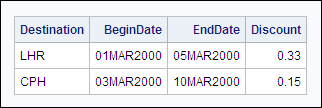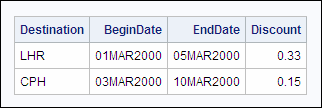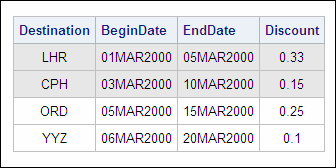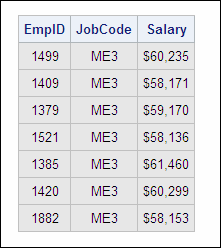Inserting Rows of Data into a Table
Overview
After you have created an empty
table, you will want to insert rows of data. You might also want to
insert additional rows of data into tables that already contain data.
You can use the INSERT statement in three different ways to insert
rows of data into existing tables, either empty or populated.
Note: You can also use the INSERT statement to insert rows
of data in a single table that underlies a PROC SQL view. To learn
more about PROC SQL views, see
Creating and Managing Views Using PROC SQL.
|
Method of Inserting
Row
|
Example
|
|---|---|
|
insert values by column
name by using the SET clause
|
proc sql;
insert into work.discount
set destination='LHR',
begindate='01MAR2000'd,
enddate='05MAR2000'd,
discount=.33
set destination='CPH',
begindate='03MAR2000'd,
enddate='10MAR2000'd,
discount=.15; |
|
insert lists of values
by using the VALUES clause
|
proc sql;
insert into work.discount (destination,
begindate,enddate,discount)
values ('LHR','01MAR2000'd,
'05MAR2000'd,.33)
values ('CPH','03MAR2000'd,
'10MAR2000'd,.15); |
|
insert rows that are
copied from another table by using a query result
|
proc sql;
insert into payrollchanges2
select empid,salary,dateofhire
from sasuser.payrollmaster
where empid in ('1919','1350','1401'), |
In each method, the
INSERT statement inserts new rows of data into the table. To indicate
that the rows have been inserted, the SAS log displays a message similar
to the following.
Here is information
about how to use each of these methods to insert rows of data into
a table.
Inserting Rows By Using the SET Clause
Sometimes you need to add
rows of data to a table, but the data is not currently contained in
any table. In this situation, you can use either the SET clause or
the VALUES clause in the INSERT statement to specify the data to be
added.
The SET clause in the
INSERT statement enables you to specify new data to be added to a
table. The SET clause specifies column names and values in pairs.
PROC SQL reads each column name-value pair and assigns the value to
the specified column. A separate SET clause is used for each row to
be added to the table.
The syntax of the INSERT statement that
contains the SET clause is shown below.
|
General form, INSERT
statement containing the SET clause:
INSERT INTO table-name <(target-column-1<,
... target-column-n)>
SET column-1=value-1<,
... column-n=value-n>
<...
SET column-1=value-1<,
... column-n=value-n>>;
table-name
specifies the name
of the table to which rows are inserted.
target-column
specifies the name
of a column into which data is inserted.
each SET clause
specifies one or more
values to be inserted in one or more specified columns in a row. Multiple
SET clauses are not separated by commas.
column
specifies the name
of a column into which data is inserted.
value
specifies a data value
to be inserted into the specified column. Character values must be
enclosed in quotation marks.
multiple column=value pairs
in a SET clause
are separated by commas.
|
Note: It is optional to include
a list of target column names after the table name in the INSERT TABLE
statement that includes a SET clause. The list can include the names
of all or only a subset of columns in the table. If you specify an
optional list of target column names, then you can specify values
only for columns that are in the list. You can list target columns
in any order, regardless of their position in the table. Any columns
that are in the table but not listed are given missing values in the
inserted rows.
Note: Although it is recommended
that the SET clause list column-value pairs in order (as they appear
in the table column list or the optional column list), it is not required.
Example
Consider the table Work.Discount,
which was presented in the last topic. Work.Discount stores airline
discounts for certain flight destinations and time periods in March.
By submitting a DESCRIBE TABLE statement, you can see this table's
columns and column attributes.
NOTE: SQL table WORK.DISCOUNT was created like: create table WORK.DISCOUNT( bufsize=4096 ) ( Destination char(3), BeginDate num format=DATE9., EndDate num format=DATE9., Discount num ); |
The following PROC SQL
step does both of the following:
-
adds two rows of new data to Work.Discount by using an INSERT statement that contains two SET clauses, one for each row
-
generates a report that displays Work.Discount, with its two new rows, by using a SELECT statement.
In this situation, you
do not need to include an optional list of column names.
Inserting Rows By Using the VALUES Clause
The INSERT
statement uses the VALUES clause to insert a list of values into a
table. Unlike the SET clause, the VALUES clause does not specify a
column name for each value, so the values must be listed in the correct
order. Values must be specified in the order in which the columns
appear in the table or, if an optional column list is specified, in
the order in which the columns appear in that list. A separate VALUES
clause is used for each row to be added to the table.
|
General form, INSERT
statement containing the VALUES clause:
INSERT INTO table-name <(target-column-1<,
... target-column-n)>
VALUES (value-1<,
... value-n)>
<...
VALUES (value-1<,
... value-n>)>;
table-name
specifies the name
of the table to which rows are inserted.
target-column
specifies the name
of a column into which data is inserted.
each VALUES clause
lists the values to
be inserted in some or all columns in one row, which is enclosed in
parentheses. Multiple VALUES clauses are not separated by commas.
value
specifies a data value
to be added. Character values must be enclosed in quotation marks.
Multiple values must be separated by commas. Values must be listed
in positional order, either as they appear in the table or, if the
optional column list is specified, as they appear in the column list.
|
Note: It is optional to include
a list of target column names after the table name in the INSERT TABLE
statement that includes a VALUES clause. The list can include the
names of all or only a subset of columns in the table. If an optional
list of target column names is specified, then only those columns
are given values by the statement. Target columns can be listed in
any order, regardless of their position in the table. Any columns
that are in the table but not listed are given missing values in the
inserted rows.
You can use the VALUES
clause to insert a value for all or only some of the columns in the
table.
|
If you want to ...
|
Then ...
|
Example
|
|---|---|---|
|
insert a value for all
columns in the table
|
You can omit the optional
list of column names in the INSERT statement.
PROC SQL
|
insert into work.newtable
values ('WI','FLUTE',6)
values ('ST','VIOLIN',3); |
|
insert a value for only
some of the columns in the table
|
You must include a list
of column names in the INSERT statement.
PROC SQL
|
insert into work.newtable
(item,qty)
values ('FLUTE',6)
values ('VIOLIN',3); |
You must list a value
for every column into which PROC SQL inserts values (as specified
in either the table list or the optional list of column names). To
specify that a value is missing, use a space enclosed in single quotation
marks for character values and a period for numeric values. For example,
the following VALUES clause specifies values to be inserted in three
columns; the first two values are missing:
values (' ', ., 45)In this example, the
first value specified is a missing value for a character column, and
the second value is a missing value for a numeric column.
Example
Suppose you want to
insert two more rows into the table Work.Discount, which stores airline
discounts for certain flight destinations and time periods in March.
In the previous section, you inserted two rows into Work.Discount
by using the SET clause, so the table now looks like the following
table.
Add two more rows, by
using the VALUES clause. The following PROC SQL step adds two rows
of new data to Work.Discount and generates a report that displays
the updated table:
proc sql;
insert into work.discount (destination,
begindate,enddate,discount)
values ('ORD','05MAR2000'd,'15MAR2000'd,.25)
values ('YYZ','06MAR2000'd,'20MAR2000'd,.10);
select *
from work.discount;The two rows that were
just inserted by using the VALUES clause are the third and fourth
rows above.
You might have noticed
that the INSERT statement in this example includes an optional list
of column names. In this example, data is being inserted into all
columns of the table, and the values are listed in the order in which
the columns appear in the table, so it is not strictly necessary to
use a column list. However, including the list of column names makes
it easier to read the code and understand what the code is doing.
Inserting Rows from a Query Result
The fastest way to insert
rows of data into a table is to use a query to select existing rows
from one or more tables (or views) and to insert the rows into another
table. You can insert rows from a query result into either an empty
table or a table that already contains rows of data. When you add
rows of data to a table that already contains rows, the new rows are
added at the end of the table.
To insert rows from a query result,
use an INSERT statement that includes the clauses that are used in
a query: SELECT, FROM, and any optional clauses, such as ORDER BY.
Values from the query result are inserted into columns in the order
in which the columns appear in the table or, if an optional column
list is specified, in the order in which the columns appear in that
list.
|
General form, INSERT
statement containing query clauses:
INSERT INTO table-name <(target-column-1<,
... target-column-n)>
SELECT column-1<,
... column-n>
FROM table-1
| view-1<,
... table-n | view-n>
<optional
query clauses>;
table-name
specifies the name
of the table to which rows are inserted.
target-column
specifies the name
of a column into which data is inserted.
SELECT
specifies the column(s)
that is inserted.
FROM
specifies the table(s)
or view(s) to be queried.
optional query clauses
are used to refine
the query further. These include the WHERE, GROUP BY, and HAVING,
clauses.
|
Note: It is optional to include
a list of target column names after the table name in the INSERT TABLE
statement that includes query clauses. The list can include the names
of all or only a subset of columns in the table. If an optional list
of target column names is specified, then only those columns are given
values by the statement. Target columns might be listed in any order,
regardless of their position in the table. Any columns that are in
the table but not listed are given missing values in the inserted
rows.
Example
A mechanic at a company
has been promoted from level 2 to level 3, and you need to add this
employee to Sasuser.Mechanicslevel3, a table that lists all level-3
mechanics. Create a temporary copy of Sasuser.Mechanicslevel3 called
Work.Mechanicslevel3_New, and display the new table in a report:
Next, you insert a row
into Work.Mechanicslevel3_New for the new level-3 employee, whose
EmpID is
1653. This employee is currently
listed in Sasuser.Mechanicslevel2, so your INSERT statement queries
the table Sasuser.Mechanicslevel2. Your PROC SQL step ends with a
SELECT statement that outputs the revised table Work.Mechanicslevel3_New
to a report.
proc sql; insert into work.mechanicslevel3_new select empid, jobcode, salary from sasuser.mechanicslevel2 where empid='1653'; select * from work.mechanicslevel3_new; |
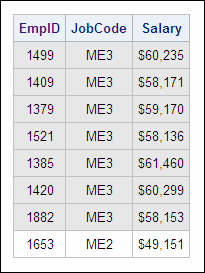 |
The row that you have
inserted into Work.Mechanicslevel3_New is row 8 above. As you can
see, the values for JobCode and Salary for the new employee have to
be changed. Updating existing values in a table is covered later in
this chapter.
Note: Although the new row is shown
here at the bottom of the table, the order of rows in a PROC SQL query
cannot be guaranteed if an ORDER BY clause is not used.
..................Content has been hidden....................
You can't read the all page of ebook, please click here login for view all page.

